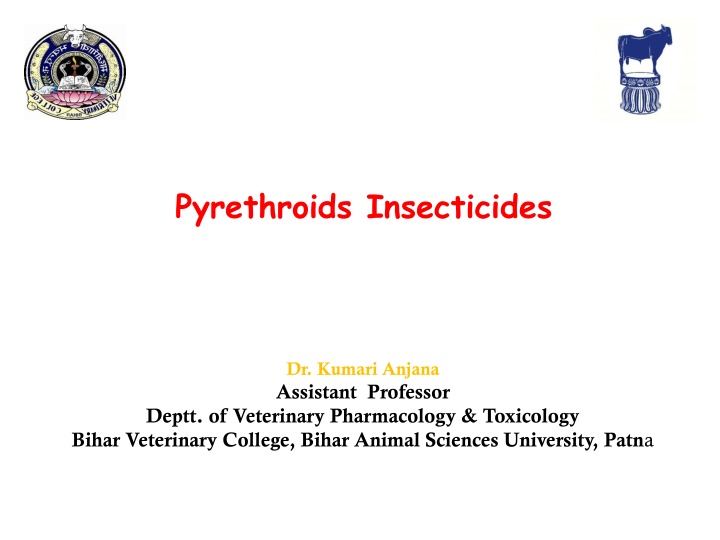
Pyrethroids Insecticides: Mechanism of Action, Clinical Signs, Diagnosis, and Treatment
Explore the world of pyrethroids insecticides, synthetic derivatives of natural pyrethrins. Understand their mechanism of action, clinical signs of toxicity, diagnosis methods, and treatment strategies. Dive into the details provided by Dr. Kumari Anjana, Assistant Professor at Bihar Veterinary College, to learn more about these important insecticides.
Download Presentation

Please find below an Image/Link to download the presentation.
The content on the website is provided AS IS for your information and personal use only. It may not be sold, licensed, or shared on other websites without obtaining consent from the author. If you encounter any issues during the download, it is possible that the publisher has removed the file from their server.
You are allowed to download the files provided on this website for personal or commercial use, subject to the condition that they are used lawfully. All files are the property of their respective owners.
The content on the website is provided AS IS for your information and personal use only. It may not be sold, licensed, or shared on other websites without obtaining consent from the author.
E N D
Presentation Transcript
Pyrethroids Insecticides Dr. Kumari Anjana Assistant Professor Deptt. of Veterinary Pharmacology & Toxicology Bihar Veterinary College, Bihar Animal Sciences University, Patna
Content of the chapter Introduction Classification Mechanism of action Clinical signs Diagnosis Treatment
Pyrethrins This is a closely related group of naturally occurring compounds that are ingredients of pyrethrum. the active insecticidal Pyrethrum is extracted from the flowers of Chrysanthemum cinerariaefoliumand has been an effective insecticide for many years. Synergists, such as piperonyl butoxide, sesamex, piperonyl cyclonene, etc, are added to increase stability and effectiveness. This is accomplished by inhibiting mixed function oxidases, enzymes that unfortunately, this also potentiates mammalian toxicity. destroy pyrethrum;
Pyrethroids These are synthetic derivatives of natural pyrethrins and include Allethrin, Cypermethrin, Decamethrin, Fenvalerate, Fluvalinate, Permethrin, Tetramethrin.
Mechanism of action Nerve poisons like DDT. Prolonged depolarization (delayed closure of Na channels) and repetitive discharge. Piperonyl butoxide and potentiate pyrethoid insecticidal and mammalian toxicity (inhibition of mixed function microsomal oxidases i.e. by preventing detoxification of pyrethroids). piperonyl cyclonene Pyrethroids are relatively less toxic in mammals and birds, but highly toxic to fish.
Clinical signs Mainly behavioural and nervous signs: Anxiety, aggressiveness, jumping over unseen objects, wall climbing, hypersensitive fasciculations/twitching of facial and eyelid muscles. to external stimuli, Spasms of fore and hind quarter muscles, champing of jaw, hyperthermia, dyspnoea, terminal convulsions, collapse and death (due to respiratory failure). In addition some autonomic signs like mild salivation (frothy), mydriasis and urination are also seen.
Diagnosis History, circumstantial evidence, clinical signs, identification of the insecticide in feed, water, ruminal content or tissues.
Treatment No specific antidote. Symptomatic nervous signs (barbiturate, chloral hydrate or diazepam), respiratory depression (analeptics). Treatment: Excitement and Reduce Absorption: Saline purgatives (not oily), gastric lavage. Supportive treatment: IV fluid and electrolyte therapy.
